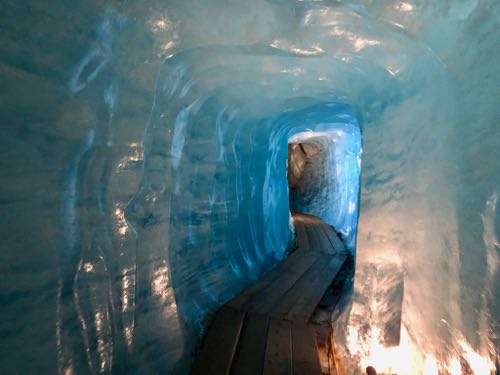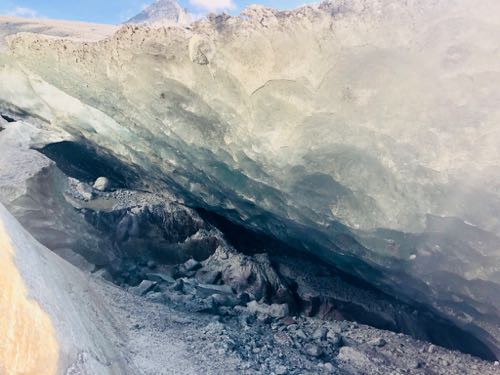Walking on Thinning Ice
I had so much anticipation going into today. Today is the day on my “Live Stream PolarConnect” event where we will be talking about our work to many classrooms and libraries. But it was also the day I had been waiting for since I found out I was chosen for the Sliding glaciers PolarTREC project.
Today is the day I would finally get to walk on a glacier!
We packed up early and drove out to the Rhône Glacier. This is also a popular tourist spot where you can even walk through an ice tunnel carved out of the glacier. They have signs prominently posted that you are not allowed to fly drones. This obviously would have been a problem for us, but Neal had stop here several weeks before to talk to the owner and explain what we were doing and obtain permission to conduct our survey.
Said permission obtained, we notified the staff that we were there for the scientific survey and we started our trek out to the glacier. The views of the glacier and the glacial lake at the foot of the ice were impressive. We checked out some of the tourist signs they had up around the site and we took at quick walk through the ice tunnel.
 Proglacial lake in front of the Rhône Glacier. When the glacier completely melts it will be called a tarn.
Proglacial lake in front of the Rhône Glacier. When the glacier completely melts it will be called a tarn.
 View of Rhône Glacier and the proglacial lake.
View of Rhône Glacier and the proglacial lake.
 Inside of the ice tunnel at Rhône Glacier.
Inside of the ice tunnel at Rhône Glacier.
 Close-up of the ice within the ice tunnel at Rhône Glacier.
Close-up of the ice within the ice tunnel at Rhône Glacier.
Rhône Glacial is unique in that it is one of the only sites were they are trying to slow the inevitable melting by placing white tarps over the ice. Now this would be impossible to do everywhere, but they have covered the area that contains the ice tunnel.
By placing white tarps over the ice in these areas, they are insulating the ice from some of the suns rays. The white color will increase the albedo (or the reflectivity of the surface) in that area and it helps to reflect, and not absorb some of the solar radiation.
The tarps are working to slow down melting a little bit in this area, but this really is the equivalent of sticking your finger in a leak in a dam that is about to burst.
 View of Rhône Glacier and the ice tunnel covered in tarps. The tarps are placed over the ice to try to prevent the ice from melting.
View of Rhône Glacier and the ice tunnel covered in tarps. The tarps are placed over the ice to try to prevent the ice from melting.
It was at about this point that my feelings of excitement started to turn to overwhelming sadness. Here it is right in front of me. Visible proof that I could reach out and touch of the effects of climate change. I was no longer enthralled by the fact that I was on the ice. All I could hear was the drip, drip, drip of the ice melting and I couldn’t ignore the deep pockets of decay in the corners of the ice in the tunnel.
But we still had work to do. So we walked along the edge of the valley until we were past the ice tunnel and started to head out onto the ice. For the first part we actually walked on the tarp, which made walking easy but a little nerve wracking because you could not see what the ice looked like underneath. Crevasses anyone?
 View across the ice at Rhône Glacier. So pretty, but so slippery in the early morning.
View across the ice at Rhône Glacier. So pretty, but so slippery in the early morning.
The four of us split up the two pairs of crampons we had so that we could each hobble across the ice by firmly planting one foot into the ice. Since it was early morning and the sun had not warmed up the top layer, there was still a nice layer of refreshed ice on the surface. I vastly underestimated how difficult it would be to cross the ice and I quickly fell on my hands and butt a few times.
Right as I thought I was getting the hang of it, my foot without the crampon slid out from under me while the crampon foot stayed in place. I watched as my ankle rolled over the top of my foot and I collapsed on the ice, again. I wasn’t really worried until I couldn’t lift myself off the ice after the first few tries and at that point I was pretty sure I sprained my ankle.
Luke noticed I was stopped and came back to assist me. I wasn’t sure I was going to be able continue and we started to make plans for me to head back. But it started to feel a little better, and with the help of Luke and Jake, and a full set of crampons, I was able to make it across.
 Jake fixing his crampons to walk across the ice.
Jake fixing his crampons to walk across the ice.
 Me and my bum ankle wait for the rest of the team to bring the equipment across the ice before they come back and help me cross.
Me and my bum ankle wait for the rest of the team to bring the equipment across the ice before they come back and help me cross.
I realize now as I write this that my Mom probably doesn’t want to hear about this part. Sorry Mom, but by the time you read this we will have already talked extensively and you know I am okay.
I guess I need to apologize to Janet and Judy too as my camera is now at the bottom of a glacier crevasse. It too was a victim to my fall. Yeah I’m 0 for about 4 today.
Once across I realized there was no way I could climb to the forefield today. And I’m mostly just super pissed at myself that I can’t help the rest of the team out. Sorry Jake, Luke, and Christian! Man, 0 for 5 now.
 The good thing about hurting your ankle by a glacier is that you have an unlimited supply of ice.
The good thing about hurting your ankle by a glacier is that you have an unlimited supply of ice.
Once I settled in with my bag of glacier ice on my foot I had a lot of time to observe the glacier. Looking across Rhône Glacier to the area covered with the tarp you could really see how much recent melting has occurred. The covered ice tunnel sticks up above the level of the rest of the glacier. If that area was not covered, it too would be melted down the level the rest of it is.
 Looking across the ice at Rhône Glacier you can see the difference in the level of the ice between the covered and uncovered areas.
Looking across the ice at Rhône Glacier you can see the difference in the level of the ice between the covered and uncovered areas.
The edges of the glacier were also showing significant decay. I could actually walk underneath part of the edge. Melting had hollowed out a concave surface underneath and you were deafened by the sound of running water barreling underneath the glacier.
 View of the underside of the Rhône Glacier.
View of the underside of the Rhône Glacier.
This is actually a huge problem for glacier recession and an even bigger uncertainty for the future of glacier melting. Many scientists believe that the increased melting and subsequent runoff of water beneath the glacier actually can cause the glaciers to slide down the mountain valleys faster, thus melting and raising sea level faster.
This relationship is one factor that helps determine the sliding laws of glaciers, and helping to determine the rates at which the glaciers slide is the primary objective of this expedition.
So my take-home message for today is, if you want to visit the Rhône Glacier, do it soon.
PolarTREC Poppy
It is hard to capture all the beauty of Rhône Glacier, but Poppy takes a moment to try to get an amazing picture.
 PolarTREC Poppy lines up her camera to try to get the perfect picture of Rhône Glacier.
PolarTREC Poppy lines up her camera to try to get the perfect picture of Rhône Glacier.
Daily Haiku
Magnificent ice
I'm sorry to see you go
Do you stand a chance?


Add new comment